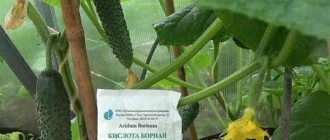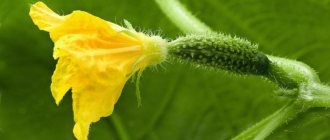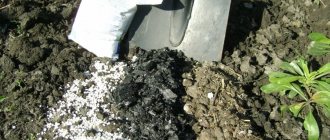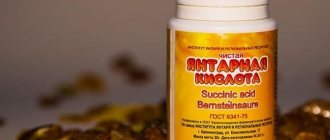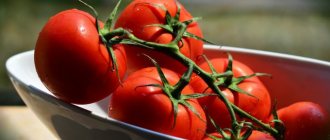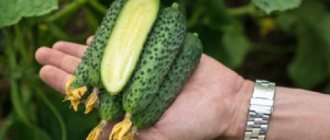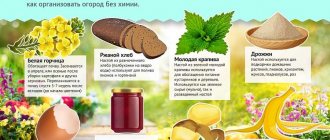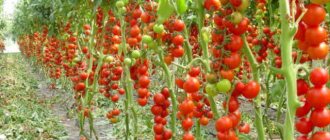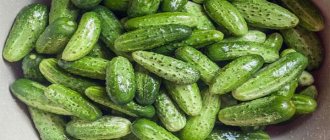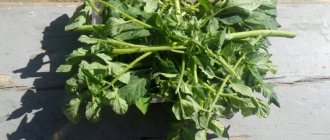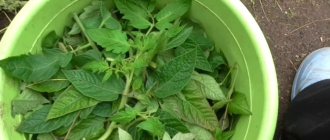Characteristics of fertilizer
Calcium nitrate is an ideal option for feeding cucumbers. It is characterized by a high nitrogen content, which is necessary for the full development of the plant. It is produced in the form of granules or white crystals, which must be dissolved in water before use.
Attention! Vegetable growers advise choosing fertilizer in powder form - it dissolves better in water.
But not all summer residents use such fertilizer, since the phosphorus and potassium content in it is insignificant. But all the same, fertilizing cucumbers with saltpeter is necessary, because... it supplies the crop with calcium, which is important for the flowering period. Thanks to this element, the roots become stronger and the fruits ripen faster than expected.
How do fertilizers affect the growth and fruiting of bushes?
Many gardeners are interested in how saltpeter mixtures affect fruiting and development of vegetable crops. Such fertilizers promote the growth of bushes and fruits, and therefore fertilizing cucumbers with saltpeter is often carried out to increase their productivity.
Experienced gardeners advise using calcium supplements when growing unproductive cucumbers in order to improve their fruiting. At the same time, it is necessary to add the composition to the soil not only after the emergence of seedlings, but also before planting the seed. This will allow you to maintain optimal levels of nitrogen and calcium in the soil.
See also
Why do yellow spots appear on cucumber leaves and what to do?
Read
Features of the use of saltpeter
It is important to feed cucumbers on time so that they do not get sick and do not become “victims” of pests. One way to do this is to use saltpeter. But to get what you want, you need to know the exact dosages and rules for using fertilizer.
Ammonium nitrate
The growth and development of cucumbers completely depends on the quality of the soil. The roots are not strong, and the flowering period of the crop is short. The quantity of fruits and their quality depend on the saturation of the plant with nitrogen, phosphorus and potassium. Ammonium nitrate for cucumbers is a source of nitrogen. But its use must be careful, otherwise its excess in a vegetable can harm human health due to nitrate poisoning.
In addition, you need to feed the cucumbers several times with ammonium nitrate, because it contains calcium and magnesium. Fertilizer is one of the most commonly used fertilizers due to the ability to mix it with other types of fertilizer. You can fertilize the beds with ammonium nitrate in dry form, or you can water it with the prepared solution.
Plants need to be fed immediately after the snow melts (winter crops). Vegetable growers also use nitrates to destroy parasites living in the soil.
Fertilizing cucumbers in a greenhouse
In order for vegetables to bear fruit for a long time and abundantly, they must be fertilized with calcium nitrate for cucumbers. In a greenhouse, the soil is rarely enriched with useful minerals. In addition to root feeding, foliar feeding is also necessary. It is better to spray the solution onto the leaves from a spray bottle, then the drops will be small and will not spread.
It is not recommended to spray in hot, sunny weather. The fertilizer will not have time to be absorbed, but will simply evaporate; the leaves may get burned and turn white. You should start feeding the plants with saltpeter for cucumbers before transplanting them into the greenhouse so that the roots have time to fully strengthen.
Composition and properties of fertilizer
The composition of calcium nitrate includes calcium (19%) and nitrogen (16%). This type of fertilizer is offered for sale granulated or crystallized. Calcium nitrate is distinguished by its good solubility in water, while its properties and use remain unchanged, even after long-term storage.
To prepare the solution, vegetable growers dilute 10 g of the substance in 5 liters of water. Gardeners use calcined nitrate on any type of soil, even with high acidity, since this indicator does not change. But it is important to maintain proportions so as not to harm the plant and human health with nitrates.
Attention!
Vegetable growers often ignore this type of feeding, believing that the crop does not need calcium. But this opinion is wrong - with a deficiency of this element, the roots begin to rot.
Owners of garden plots avoid using potassium fertilizers for cucumbers, opting for ammonium nitrate. This is not surprising - it contains nitrogen (26-34%), necessary for the vegetable, as well as potassium and calcium. As a result of its use, the tops turn green and become thicker, and the fruits ripen earlier.
Types of nitrogen fertilizer
In terms of origin, mineral and organic fertilizers containing nitrogen are distinguished. Based on the number of active mineral compounds, a distinction is made between complex and single-component formulations, which are applied by the root or foliar method (sprayed onto the leaf).
Did you know? To make the worn surface of a shoe look like new, just wipe it with the pulp of a fresh cucumber.
Organic
Nitrogen is included in small amounts in all types of droppings. Typically this figure varies between 0.5–1%, and in poultry – 1–2.5%. The largest amount of this element is found in chicken, duck and pigeon droppings. However, these types of organic matter are also the most toxic.
Within 1.5% nitrogen is contained in peat-based compost. 0.4–0.7% of the substance includes green legumes, clover, sweet clover, and from 1 to 2.5% - river silt.
Urea
It is small white granules of white color, odorless. After entering the soil, the main substance is converted under the influence of microflora into ammonium carbonate. Upon contact with air, nitrogen is converted into ammonia gas, so the product is applied directly to the soil to a depth of 7–10 cm or diluted in water. Top dressing can be used as root and foliar fertilizer. When sprayed on a leaf, it does not cause burns.
Important! Urea is not compatible with deoxidizing agents such as lime, chalk, wood ash, or superphosphate. Urea is intended to accelerate the growth of the above-ground part of the plant, as well as to eliminate pests (aphids, copperheads, weevils) and some types of fungal diseases (scab, purple spot)
Urea is intended to accelerate the growth of the above-ground part of the plant, as well as to eliminate pests (aphids, copperheads, weevils) and some types of fungal diseases (scab, purple spot).
Urea (carbamide) contains 46% nitrogen.
When applied during the budding period, it can cause them to fall off. More effective when applied in spring. If you use it in the fall when preparing the soil, before the onset of the season the bulk of the nitrogen will already lose its quality.
Find out more about how to properly feed cucumbers with urea.
Ammonium nitrate
In appearance, this substance resembles urea, but its granules are larger and have a yellowish tint. The fertilizer is intended only for root feeding of garden and indoor plants. It is diluted with water for irrigation or applied dry to moist soil to a depth of about 10 cm. When used for leaf feeding, ammonium nitrate leaves burns.
It is acceptable to use ammonium nitrate for cucumbers until the fruit begins to form. Do not add the substance together with peat, sawdust or straw, as their interaction may cause a fire.
Ammonium nitrate (ammonium nitrate) contains 34% nitrogen.
Calcium nitrate
The product is an inorganic nitrate salt. The use of this type of fertilizer is justified on all types of soils. It will be especially useful to apply the product on soddy-podzolic and heavy podzolic soils with high acidity, on which other nitrogen fertilizers will cause even greater oxidation.
Important! Calcium nitrate is highly hygroscopic, so it must be stored only in well-sealed original packaging or poured into a dry glass container with a tight-fitting lid. Calcium nitrate is intended for feeding cucumbers and other garden crops at all phases of the growing season until flowering
Can be used as root and foliar feeding
Calcium nitrate is intended for feeding cucumbers and other garden crops at all phases of the growing season until flowering. Can be used as root and foliar feeding.
Calcium nitrate contains 13% nitrogen and 19% calcium.Sodium nitrate
In this regard, it is used much less frequently than other types of nitrogen fertilizers. The thing is that not all crops can tolerate an excess of sodium. In addition, it has the ability to accumulate in fruits.
For cucumbers, the use of sodium nitrate is justified only in spring on large areas. Also, this fertilizer is not suitable for feeding plants cultivated in greenhouses or at home. In some cases, the substance begins to emit toxic fumes already at room temperature.
The composition of sodium nitrate includes about 17% active nitrogen and 26% sodium.
Advantages and disadvantages of saltpeter for cucumbers
Before you start applying fertilizer to cucumber beds, you need to choose it and study its advantages and disadvantages. Saltpeter is one of the popular ways to feed plants in the garden, due to the following advantages:
May be interesting When to plant cucumbers in May 2021 according to the lunar calendar Planting cucumbers in plastic containers Feeding cucumbers during flowering and fruiting
- accelerated photosynthesis - the tops develop faster, and the leaves do not turn yellow;
- increase in the number of fruits - all types of nitrate contain microelements that have a beneficial effect on the development of the crop, as a result of which a rich harvest can be harvested;
- fast germination - if you treat the seed material with calcium nitrate before planting, it will germinate more quickly;
- resistance to diseases and pests;
- improved taste and appearance - fertilizing with such means makes the vegetable juicy and tasty;
- resistance to sudden temperature changes.
Despite this list of advantages, saltpeter also has a disadvantage. Fertilizer is a nitrate, so its abuse can only cause harm. But if you strictly adhere to the proportions when preparing the solution, then neither the crop nor the person is in danger.
Fertilizing greenhouse cucumbers
Cucumber is one of the fastest ripening vegetable crops. Does not require seedling cultivation. In greenhouses and greenhouses it ripens earlier than other vegetables. If you use all the rules and regulations, you can achieve the desired yield.
It is necessary to provide:
- fertile soil;
- sufficient lighting;
- timely watering;
- the right fertilizer.
Cucumbers require a potassium solution, which nourishes the root system, and through it the entire plant is enriched. Pay attention to the composition of the fertilizer. Chlorine, which is part of many fertilizers, is categorically harmful to cucumbers. Experiment with individual bushes before applying fertilizer. If after 4–5 days the appearance of the fed vegetables does not deteriorate, feel free to fertilize the rest.
In greenhouses you need to be especially careful with fertilizing. In hot, sunny weather, feeding and spraying cannot be done. In addition to chemical fertilizers, you can use safer ones - organic ones. The most famous and popular is manure. Plants are fed with its solution throughout the season.
With the onset of cold weather, cucumbers stop growing and bearing fruit; there is no point in applying fertilizer. With the appearance of fruit set, fertilizing with chemical fertilizers must be stopped; instead, you can switch to organic matter, which does not contain substances harmful to health, and the result is no worse.
When is saltpeter feeding necessary?
Vegetable growers, especially beginners, do not know when to start using saltpeter as a fertilizer. It is necessary to feed cucumbers as soon as the first signs of calcium or nitrogen deficiency in the crop are noticed. If you don’t start solving this problem in a timely manner, then you can forget about a good harvest.
In addition, the need for fertilizers of this type increases if cold weather with frequent precipitation persists for a long period. If you fertilize on time, the fruiting stage will be increased.
How to prepare the solution
As soon as you have transplanted cucumber seedlings into open ground, they need to be fed with nutrients. If ammonium nitrate is chosen as a fertilizer, then it must be dissolved in warm water. The ratio of components is as follows: 10 g of fertilizer per bucket of water.
Fertilizer should be applied a maximum of 10 times per season. Its effectiveness is noted by experienced gardeners.
Attention!
If the crop does not have problems with growth and yield, then fertilizing is not needed.
It is important to remember that an excess of nitrogen harms the vegetable. The use of ammonium nitrate is unacceptable during the fruiting period, because cucumbers will absorb nitrates. It is suitable for regions with any climate.
Before adding calcium nitrate, you need to prepare a solution. To do this, mix 5 liters of water, 400 g of fertilizer and 700 g of lime, bring to a boil and simmer for at least half an hour. After the liquid stops smelling unpleasantly, remove it from the heat and leave for 2 hours.
Potassium nitrate fertilizer also needs to be prepared correctly. To do this, mix 15 g of the substance with 5 liters of liquid, 65 g of ash, 10 g of urea. Leave for 1.5 hours and use the mixture to water the bushes.
Making calcium nitrate yourself
Gardeners know that calcium nitrate is not as widespread as ammonium nitrate. Therefore, some people prepare it themselves at home. To do this, you will need to prepare the following components and accessories:
- Ammonium nitrate.
- Slaked lime.
- Bricks.
- Aluminum pan.
- Firewood.
You will also need a respirator for respiratory protection and gloves. You should not prepare the mixture close to the house, as the process will release an unpleasant odor. So, first you need to build a structure for the fire from bricks. The bricks should be placed at such a distance that the prepared pan will fit there. Next, pour 0.5 liters of water into the container and add about 300 g of saltpeter. Now put the prepared mixture on the fire and wait until it starts to boil. Then lime must be gradually added to the solution. For this number of components you will need about 140 grams of slaked lime. You need to add it in very small portions so that the entire process of adding lime takes 25 minutes.
The mixture continues to be cooked until it completely gets rid of the pungent unpleasant odor. Now the fire is extinguished, and the mixture is left to settle until a lime deposit appears at the bottom of the container. After this, the upper part of the mixture is drained, and the formed precipitate can be discarded. This solution is calcium nitrate.
Important! It is necessary to dilute the mixture depending on what type of plants should be fed. The amount of water also changes during root application and spraying.
Use of saltpeter
Summer residents use saltpeter in their garden plots. This is not surprising, because with its help the stems and foliage of vegetable crops actively develop, and it also has a beneficial effect on the harvest. But you need to know how to use this substance to feed cucumbers in a greenhouse and in open ground.
Fertilizing cucumbers in a greenhouse
Vegetables growing in a greenhouse need root and foliar fertilizer, because... In closed ground there are few nutritional components. For spraying, you need a spray bottle so that drops of the solution fall on the leaves and do not spread.
You need to fertilize cucumbers in a greenhouse in the morning or evening. If you carry out the procedure during the day, the substance will not only not be absorbed, but will also damage the foliage - the drops will act as lenses and cause a burn.
Attention!
You can apply fertilizer during the day, but only in cloudy weather.
In order for the roots of the crop to become stronger, they begin to be fed with saltpeter even before transplanting into the greenhouse. After planting, the fertilizer scheme is as follows:
- During the formation of the first two true leaves.
- 2 weeks after the first procedure.
- The third mandatory feeding should be carried out 30 days after the second.
Saltpeter in granules or crystals is suitable for preparing the solution. Experienced vegetable growers prefer the second type, since it dissolves in water faster and is easily absorbed by the soil.
Fertilizing cucumbers in open ground
If the seedlings will grow in open ground, then fertilizer must be applied in the spring when digging. Vegetable growers often make a mistake and add it in the fall. But in this case, all useful microelements will be washed out of the soil along with the snow.
If calcium nitrate is used, it should not be combined with other fertilizers containing nitrate and sulfate. It will help seedlings appear faster. Crops need feeding during the first period of growth. At subsequent stages of plant development, it also needs to be added.
Doses of nitrate: at the initial stage, dilute 1 tbsp. substances in 6 liters of water. Gradually increase the proportions, but they should not exceed 3 tbsp.
Application
Strengthening roots, stimulating growth, increasing productivity - to achieve all these goals, you can feed cucumbers with saltpeter. Whether it’s worth doing it with her is another question!
First feeding of cucumbers: tips for choosing fertilizers and methods of their use. Step-by-step instructions for beginnersSelf-pollinating varieties of cucumbers are the best varieties for greenhouses and open ground. Features of planting and growing self-pollinating cucumbers (90 photos)
Cold pickling of cucumbers: step-by-step description of the traditional cooking recipe, subtleties and tricks of canning cucumbers (125 photos + video instructions)
Some gardeners prefer organic matter - compost, manure, bird droppings. Those who prefer saltpeter use it both dry and liquid (sprinkle and water the beds). Apply immediately before sowing.
You can simply dig up the bed along with the fertilizer. This cannot be done in the fall, since the melting of snow will wash out nitrogen from the soil.
When feeding with calcium nitrate, it is important to observe the correct dosages and proportions:
- For fertilizing various berries – 50g/20 l;
- For vegetables – 25g/15l;
- For watering fruit trees (before buds open) – 25g/10l;
- For spraying (foliar feeding) – 10g/5l. Spraying can be done every 2 weeks with the appearance of the first three leaves, before fruiting begins.
Correct application technology
To properly fertilize cucumbers, it is important to know the technology for applying nitrate. You need to carry out the procedure:
- Before planting seedlings in garden beds. Dry matter is added to the ground. It must be poured 8-10 g into each hole and mixed well with the soil. Otherwise, you can burn the root system of the plants.
- During the flowering period. Nitrate must be diluted with water: 35 g of fertilizer per 15 liters of warm liquid. Apply 1.5 liters per bush using the root method.
- At the stage of fruit formation. In this case, foliar feeding is necessary. Spray in the morning and evening. This approach will avoid diseases and activate the immune system.
If you adhere to these rules, then there will be no problems with growing cucumbers.
Errors in using ammonium nitrate
Ammonium nitrate is not used during the flowering period of plants.
But ornamental crops that bloom all summer can be additionally fed with saltpeter in July, between waves of flowering. When choosing ammonium nitrate for fertilizing, you need to know the rules for its use. The following mistakes should not be made when using it:
- Mixing with organic fertilizers. Nitrate cannot be combined with compost, manure, sawdust, straw, humus, or peat. Find out → how to prepare compost + recipes.
- Mixing with other mineral fertilizers. This substance is not compatible with other types of saltpeter and with superphosphate (find out. → the use of superphosphate as a fertilizer, how to dilute + reviews).
- Mixing with lime, chalk, dolomite flour. The liming of the soil and the addition of ammonium nitrate should be spread far apart over time.
It is also important to store saltpeter correctly. This should be done in a sealed package, in a cool room with good ventilation, away from moisture and sunlight. Strong temperature changes and temperature increases above +27-300C are unacceptable. When organizing storage, three features of ammonium nitrate should be taken into account: hygroscopicity, the ability of nitrogen to volatilize and the ability of nitrate to spontaneously ignite.
What fertilizers are prohibited from being used together?
Gardeners, especially beginners, mistakenly assume that saltpeter can be used with any type of fertilizer. But that's not true. Types of fertilizers with which saltpeter is not compatible:
- straw;
- sawdust;
- phosphate;
- manure;
- chalk.
Attention!
It should also not be mixed with fertilizers that contain phosphorus.
It is better to use ammonium and calcium nitrate with urea and urea. This solution will allow you to get a good harvest.
When to fertilize
In addition to calcium, cucumbers are fed with ammonium nitrate. Fertilizer is sprinkled on open ground even before the snow has completely melted.
Interesting. A large amount of nitrogen is contained in ammonia. But excessive application of this nitrogen-containing fertilizer negatively affects the composition of the greens; they are saturated with nitrates. It is also prohibited to irrigate cucumber leaf blades with an ammonia solution from a spray bottle. This leads to the formation of burns on the foliage and lack of harvest.
To benefit the shrubs, fertilizing is applied under the soil layer, 10 cm deep into the soil substrate. Ammonium nitrate is used for cucumbers in diluted form and does not harm the plant.
Thus, different types of preparation can be used to fertilize cucumbers: potassium, ammonia and calcium. You need to know how to use them correctly and what volume is suitable for feeding.
For soils with high acidity, calcium nitrate is simply necessary. Calcium nitrate absorbs iron, manganese and metal acidity in the soil. When receiving calcium contained in nitrate, the root system begins to develop fruitfully. Therefore, fertilizing cucumbers is necessary after 7–10 days.
Safety precautions when working with substances
Nitrate is not included in the group of toxic substances and is therefore recognized as safe for humans. In addition, working with it does not cause an allergic reaction. But this does not mean at all that when using fertilizing, you can neglect basic safety measures.
If you need to feed cucumbers in a greenhouse, you should work with gloves, safety glasses and respiratory masks. In addition, it is important to protect exposed skin. If nitrate gets on them, wash thoroughly with plenty of water.
Is it possible to feed cucumbers with saltpeter?
Before feeding cucumbers, you need to figure out whether it is possible to use saltpeter mixture for this. Some vegetable growers claim that saltpeter should not be used when growing cucumber bushes, but this is not true. This fertilizing promotes the growth of vegetables, as it contains many useful nutrients. It saturates the soil with potassium, calcium, nitrogen, sodium and magnesium.
To prevent the saltpeter fertilizer from harming the planted vegetables, you must use it correctly and follow the dosage.
Storage conditions and contraindications
It is impossible to mix saltpeter with phosphates, sulfates and organic fertilizers. As a result of their interaction, a reaction will occur that is harmful not only to cucumbers, but also to humans.
The substance should not be stored with flammable materials, peat, straw, sawdust, as there is a high risk of fire. For the same reason, the fertilizer should be completely excluded from exposure to sunlight. It's better to choose a cool place.
You need to feed cucumbers carefully, strictly maintaining the proportions and timing of the procedure. Otherwise, nitrates will accumulate in vegetables. To store nitrogen-containing fertilizers, you should give preference to paper or plastic bags.
Reviews
Dmitry, Krasnodar
I bought a summer cottage a year ago and decided to plant cucumbers. I knew that I needed to fertilize, but I didn’t know what exactly. Friends recommended saltpeter, but I didn’t understand how to add it. So I watched the video online. I was afraid, of course, I thought I would overdo it, but everything went well. Moreover, the foliage grew immediately, and I received the harvest earlier than expected. I would like to advise beginners: after applying fertilizer, water the crop.
Larisa, Samara
My husband and I set up a greenhouse on our property and planted early varieties of cucumbers. How surprised I was that they did not grow very quickly. But the situation changed after using saltpeter.
There is nothing complicated in using this type of fertilizer. The main thing is to adhere to the application plan and observe safety precautions.
